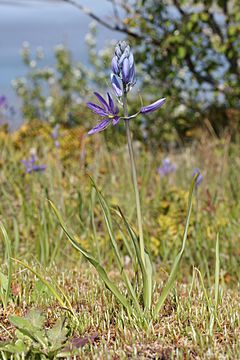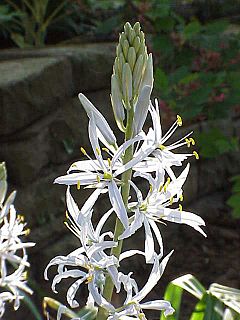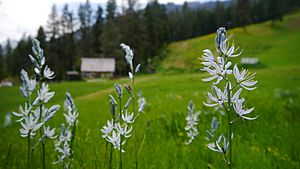Camas facts for kids
Quick facts for kids Camas |
|
|---|---|
 |
|
| Indian camas (Camassia quamash) | |
| Scientific classification |
|
| Kingdom: | Plantae |
| Clade: | Tracheophytes |
| Clade: | Angiosperms |
| Clade: | Monocots |
| Order: | Asparagales |
| Family: | Asparagaceae |
| Subfamily: | Agavoideae |
| Genus: | Camassia Lindl. |
| Type species | |
| Camassia quamash (Pursh) Greene |
|
| Synonyms | |
Camassia is a genus of plants in the asparagus family native to western North America. Common names include camas, quamash, Indian hyacinth, camash, and wild hyacinth.
It grows in the wild in great numbers in moist meadows. They are perennial plants with basal linear leaves measuring 8 to 32 inches (20 to 81 cm) in length, which emerge early in the spring. They grow to a height of 12 to 50 inches (30 to 127 cm), with a multi-flowered stem rising above the main plant in summer. The six-petaled flowers vary in color from pale lilac or white to deep purple or blue-violet. Camas can appear to color entire meadows when in flower.
Contents
Taxonomy and species
Historically, the genus was placed in the lily family (Liliaceae), when this was very broadly defined to include most lilioid monocots. When the Liliaceae was split, in some treatments Camassia was placed in a family called Hyacinthaceae (now the subfamily Scilloideae). DNA and biochemical studies have led the Angiosperm Phylogeny Group to reassign Camassia to the family Asparagaceae, subfamily Agavoideae.
Species
The World Checklist of Selected Plant Families recognizes six species as of April 2015[update]:
- Camassia angusta (Engelm. & A.Gray) Blank. - prairie camas - southern Great Plains + mid-Mississippi Valley (TX OK LA AR MO KS IA IL IN)
- Camassia cusickii S.Watson - Cusick's camas - northeastern Oregon, west-central Idaho
- Camassia howellii S.Watson - Howell's camas - southwestern Oregon
- Camassia leichtlinii (Baker) S.Watson - large camas, great camas - British Columbia, Washington, Oregon, northern + central California, Washoe County in Nevada
- Camassia quamash (Pursh) Greene - quamash, Indian camas, small camas - western Canada (BC AB), western USA (CA OR WA NV ID MT WY UT)
- Camassia scilloides (Raf.) Cory - Atlantic camas, bear grass - eastern + Central North America from Maryland to Georgia, westward to Texas and north into Ontario.
- formerly included
The name Camassia biflora was coined in 1969 for a South American species now known as Oziroe biflora.
Synonyms
The term Camassia esculenta is a confusing one. Not an accepted name, it has been used twice, both for Camassia quamash and for Camassia scilloides. Consequently, the reference to Camassia esculenta (Ker Gawl.) B.L.Rob. as a synonym for C. scilloides is deemed illegitimate, while reference to Camassia esculenta (Nutt.) Lindl. is a non-accepted name (synonym) for C. quamash subsp. quamash. Hence the continuing horticultural usage without qualification is potentially confusing.
Cultivation and uses
Indigenous methods of cultivation
Indigenous peoples of the Pacific Northwest engaged in the active management and cultivation of Blue Camas. Controlled burning was employed to clear land and improve growing conditions for Blue Camas. While Camas plots occurred naturally in the Pacific Northwest, Indigenous peoples would maintain a plot through the planting and harvesting of Camas bulbs, as well as by tilling and weeding. Camas plots were harvested by individuals or kin-groups, who were recognized as a particular plot’s cultivators or stewards. Stewardship was typically lineage-based, and cultivation rights to a particular plot were fiercely guarded. Multiple generations would often harvest the same Camas plot. Plots have been recorded as possessing physical boundary markers, and there were social consequences for harvesting from a plot that was recognized as being maintained by a particular individual or kin-group. The camas bulbs were harvested with a pointed wooden tool, with the work of cultivation being done primarily by women.
Food use
Camassia species were an important food staple for Indigenous peoples and settlers in parts of the American Old West. While Camassia species are edible and nutritious, the white-flowered deathcamas species (which are not in the genus Camassia but in a number of genera in the tribe Melanthieae) that grow in the same areas are toxic, and the bulbs are quite similar in appearance. It is easiest to tell the plants apart when they are in flower.
The quamash was a food source for many indigenous peoples in western North America. Blue Camas was harvested when in bloom, in spring or early summer. After being harvested the bulbs were pit-roasted or boiled. A pit-cooked camas bulb looks and tastes something like baked sweet potato, but sweeter, and with more crystalline fibers due to the presence of inulin in the bulbs. The eating of too many such baked bulbs - especially if undercooked - can cause excessive flatulence, due to their containing inulin and other oligosaccharides. When dried, the bulbs could be pounded into flour. Native American peoples who ate camas include the Nez Perce (Nimíipuu), Cree, Coast Salish, Kalapuya, and Blackfoot, and Yakama among many others. The Kutenai called the camas "xapi" (Ktunaxa). Camas bulbs contributed to the survival of members of the Lewis and Clark Expedition.
In the Great Basin, expanded settlement by whites accompanied by turning cattle and hogs onto camas prairies greatly diminished food available to native tribes and increased tension between Native Americans and settlers and travelers. Though the once-immense spreads of camas lands have diminished because of modern developments and agriculture, numerous camas prairies and marshes may still be seen today.
Ornamental use
This bulbflower naturalizes well in gardens. The bulb grows best in well-drained soil high in humus. It will grow in lightly shaded forest areas and on rocky outcrops as well as in open meadows or prairies. Additionally it is found growing alongside streams and rivers. The plants may be divided in autumn after the leaves have withered. Bulbs should be planted in the autumn. Additionally the plant spreads by seed rather than by runners.
Place names
Many areas in the Pacific Northwest are named for the plant, including Camas Valley, Oregon; the city of Camas, Washington; Lacamas Creek in southern Washington; the Camas Prairie in northern Idaho (and its Camas Prairie Railroad); Camas County in southern Idaho; and Kamas, Utah.
Role in indigenous trade and culture
Camas was an important component of the diets of most indigenous groups located in the Pacific Northwest. However, not all indigenous groups harvested Camas themselves. Instead, many relied on trade in order to procure it. Indigenous groups that lived in environments that suited camas production, such as the Coast Salish, developed networks of exchange in order to procure a variety of goods and foods, such as cedar bark baskets and dried halibut.
In North American Indigenous cultures, trade had economic as well as diplomatic functions, with ceremonies such as the potlatch serving as a means to legitimize an individual’s rule and establish their status as a provider. Camas was frequently traded in large volumes for such occasions.
Theories of anthropogenic dispersal
As indigenous land-management techniques have been theorized as having had a significant impact on the maintenance of the Garry oak ecosystem, one of the primary ecosystems in which Camassia quamash grows, researchers have investigated the potentiality of anthropogenic transport through an investigation of the genetic structure of Camassia quamash. Despite historical evidence for anthropogenic maintenance of Camas plots and transportation through Indigenous trade networks, analysis of the genetic structures of Camassia quamash have not substantiated theories of anthropogenic dispersal. The distribution of Camassia quamash across the Pacific Northwest is most likely the result of postglacial migration. These results imply that the degree of anthropogenic dispersal of Camassia quamash that occurred was not of such a scale as to leave a marker in the plant’s genetic structure.
See also
 In Spanish: Camassia para niños
In Spanish: Camassia para niños



